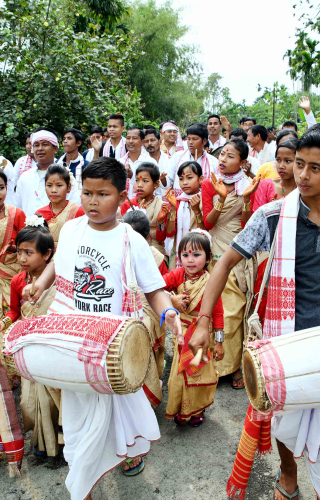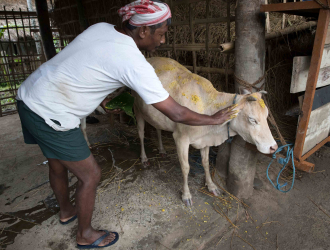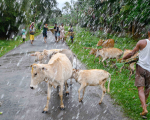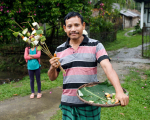The geography, culture and civilisation of the Northeast has been shaped by the river Brahmaputra. The river originates in Tibet and after flowing through Assam, meets the Ganges and Meghna in Bangladesh forming the Sunderban Delta on the Bay of Bengal. This massive riverine ecosystem forms the geographical, ethnic and cultural separation point between Southeast Asia and the Indian subcontinent. The history of these two regions developed independently and rarely overlapped. This distinction is important to understand the nuances of Assamese culture.
The Brahmaputra Valley has a rich history. Over centuries, many tribes and ethnic groups migrated to the fertile Brahmaputra plains from neighbouring areas like Bengal, Bhutan, Burma, Tibet, Southern China and Thailand. The kingdom of Kamrup existed in this region for a millennium before the arrival of the Ahoms in 1228 CE. Ethnically, the Ahoms were from the Shan or Tai warrior group from the Shan country. Over time, they expanded their territory, bringing all the tribes and kingdoms in the region under their unified rule and giving the land its current name—Axom or Assam. The Ahoms successfully resisted invasion from the Mughals in the west and the Burmese in the east, ruling Assam for 600 years. Finally, the East India Company annexed Assam in 1826 CE with the signing of the Treaty of Yandabo, integrating it with British India. In 1947, Assam became a part of independent India, but ethnically it continues to have deep-rooted links with Southeast Asia.
Assam’s present cultural landscape was largely shaped under the patronage of the Ahoms. The Tai culture which the early Ahoms practised had books on history, astrology, religious ethics, mythology and scriptures written in the Tai language. Interestingly, when they settled in the Brahmaputra plains, they did not overrule or destroy what the land previously had. They did not make Tai the official language of the kingdom, nor did they try to discard the prevailing Hindu and Buddhist influence of the Indian subcontinent. Rather, in the 15th and 16th centuries, the Ahom kings embraced neo-Vaishnavism which was popularised in the region by Sankardev. The Ahoms also assimilated and integrated many elements from Tantric and Shakta cults and animist practices from local tribal populations.
For the Frames Photography Grants, I decided to document Rongali Bihu in Sibsagar district, a region which was the capital of the Ahom dynasty from 1699 to 1788. During this period, the Ahom rulers built the Rang Ghar in Sibsagar town, a large amphitheater where the early Bihu festivities originated. Rongali Bihu, also called Bohag Bihu, marks the Assamese new year (Baisakh in Hindu calendar or mid-April in Gregorian calendar). Next is the Kongali or Kati Bihu, which is observed in October, followed by Bhogali or Magh Bihu in the month of January. During Rongali Bihu, people offer prayers for a prosperous agricultural season and prepare the field for ploughing and sowing of fresh seeds. Hence the festival also marks the beginning of the agricultural cycle.
Rongali Bihu is not a festival in the strictest sense, but more of a celebration of life and love—not only between humans, but also with animals and nature. For example, the day of Baisakh Sankranti is known as Goru (cattle) Bihu, and on this day cattle and livestock are washed, scrubbed with special herbs, and fed specially made food items. To signify the beginning of a new season, new clothes are handwoven at home by female members of a family. On this day, a fresh gamosa is worn by men and women wear mekhela-chador made from Assam silk. The gamosa is also offered to guests along with tamul (areca nut) and paan (betel leaf). To celebrate the new year, visits are made to families, relatives and friends. A wide variety of culinary items are prepared from rice and xaak (green vegetables), along with beverages like xajpani (rice beer).
Other than being a symbol of fertility, Rongali Bihu is also a manifestation of selfless love or Bhakti, which has roots in the Ekasarana Dharma established by Srimanta Sankardev in the satras (monasteries) from the 16th century onwards. The followers of Ekasarana Dharma reject ritual worship of idols and polytheism, instead they venerate the Bhagwata scripture and connect with the divine by chanting the name of Krishna (or the names of his various avatars) in the namghar (prayer house). Men and women have equal access to the namghar and there is no untouchability or segregation based on differences of caste, age, gender or class. The concept of sharing love and social equality is expressed in many different ways. Young boys and girls participate together in the Hosuri dance performances, for which they visit every village household and wish for their prosperity. On the first day of Baisakh, which marks the Manuh Bihu, blessings are sought from the elders of the families and communities congregate at the village namghar to offer prayers. Social events and gatherings like these may continue for the entire month of Baisakh.
The festival of Bihu is intricately linked to the life and culture of rural Assam, thus, the nuances of the festival can only be witnessed in the countryside. This is the reason I wanted to document the Rongali Bihu of the villages rather than the Rang Ghar, where the festival is organised by the state government for large crowds, foreign tourists and the media. In the latter case, these events are stage-managed and lack the sense of community participation which is an integral aspect of the festival. The celebration of life, which is intrinsic to Rongali Bihu, cannot be artificially recreated in an urban setting. Away from the manufactured carnival of the cities, Rongali Bihu is a living tradition of the syncretic culture of rural Assam.

















